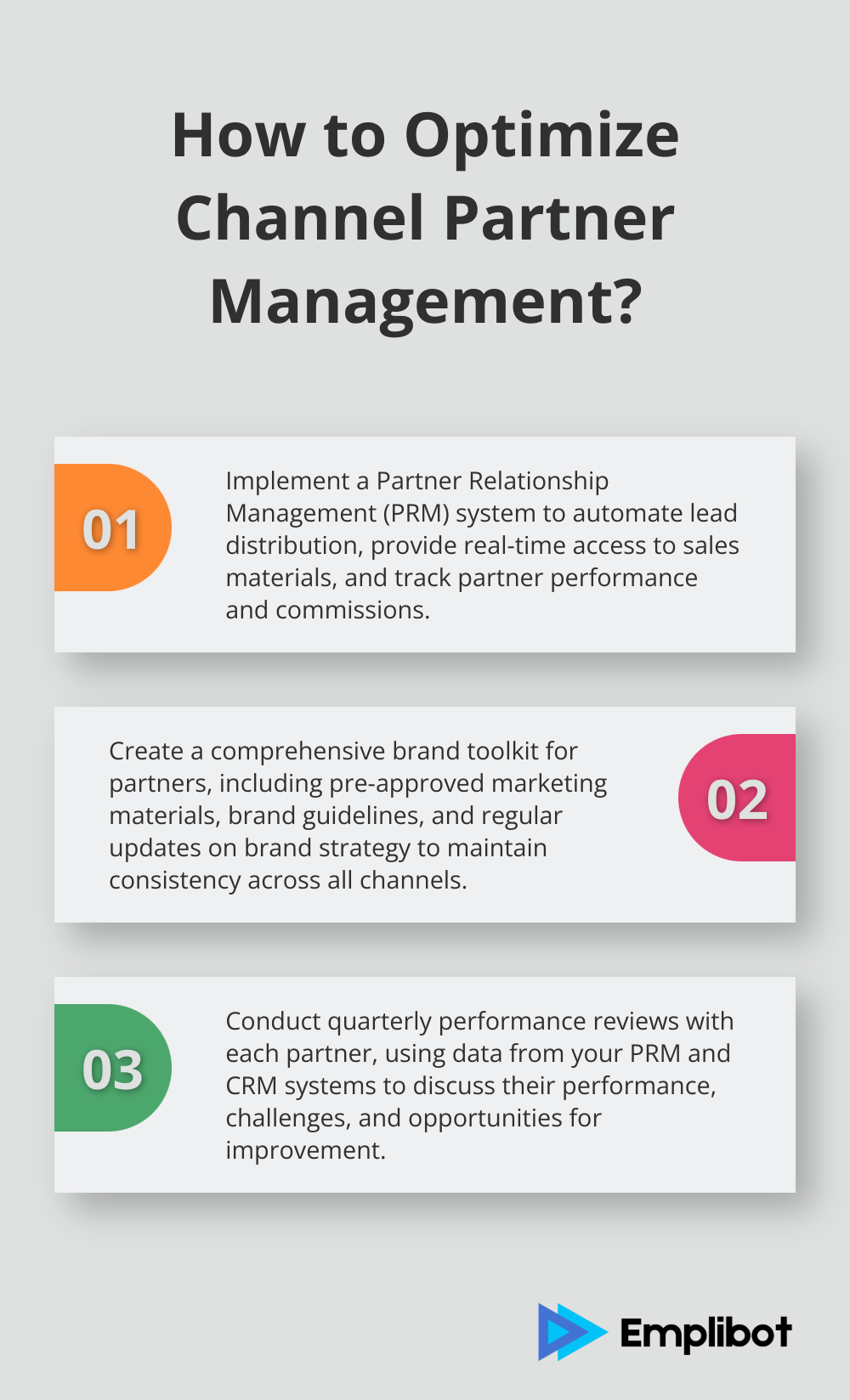At Emplibot, we’ve seen firsthand how indirect channels marketing can revolutionize a company’s reach and revenue.
Indirect channels offer a powerful way to expand your market presence without the hefty investment of direct sales forces. By leveraging intermediaries like distributors, resellers, and affiliates, businesses can tap into new customer bases and markets.
This blog post will explore how to effectively harness the potential of indirect channels, from selecting the right partners to measuring your success.
Contents
ToggleWhat Are Indirect Marketing Channels?
Definition and Types
Indirect marketing channels are third-party entities that help businesses reach their target audience without direct interaction. These channels act as intermediaries between companies and their customers, facilitating product or service distribution and marketing efforts.

Several types of indirect marketing channels exist:
- Distributors: Companies that purchase products in bulk from manufacturers and sell them to retailers or directly to consumers. (For example, a food distributor might buy large quantities of snacks from various manufacturers and sell them to grocery stores.)
- Retailers: Businesses that sell products directly to consumers, including brick-and-mortar stores and online platforms. (Amazon, for instance, is a major retailer that sells products from countless brands.)
- Affiliates: Individuals or companies that promote a business’s products or services in exchange for a commission on sales. Many bloggers and influencers use affiliate marketing to monetize their content.
- Value-Added Resellers (VARs): Companies that add features or services to an existing product and then resell it. In the tech industry, VARs often bundle software with hardware and provide additional support services.
The Power of Indirect Channels
Indirect marketing channels offer numerous benefits for businesses:
- Expanded Reach: Companies can access new markets and customer segments by tapping into established networks. A study by Forrester Research found that 75% of world trade flows indirectly, highlighting the vast potential of these channels.
- Cost Efficiency: The use of indirect channels can prove more cost-effective than building and maintaining a direct sales force.
- Expertise and Local Knowledge: Channel partners often possess deep industry knowledge and understand local market nuances. This expertise can prove invaluable, especially when entering new geographical markets.
- Scalability: Indirect channels allow businesses to scale their operations quickly without significant upfront investments.
- Risk Mitigation: The diversification of sales channels reduces dependence on any single route to market, thereby mitigating risks associated with market fluctuations or channel-specific issues.
Challenges to Consider
While indirect marketing channels offer numerous advantages, they also present challenges. These include potential loss of control over brand messaging, reduced profit margins due to revenue sharing, and the need for ongoing partner management and support.
To maximize the benefits of indirect channels, businesses must carefully select their partners, provide comprehensive training and support, and maintain clear communication channels. Companies can harness the full potential of indirect marketing channels and drive sustainable growth through proactive management of these challenges.
As we move forward, we’ll explore effective strategies for leveraging these indirect channels to their fullest potential, ensuring your business can reap the maximum benefits from this powerful marketing approach.
Maximizing Indirect Channel Partnerships
Choose the Right Partners
Selecting the right partners is essential for success in indirect channel marketing. Companies should look for partners that align with their values and have a strong presence in the target market. A study by Accenture reveals that 76% of IT executives identify IT as the primary area for gen-AI transformation over the next three years. This highlights the importance of choosing partners who can adapt and grow with your business.

When evaluating potential partners, consider their:
- Market reach and customer base
- Industry expertise and reputation
- Financial stability
- Technological capabilities
- Willingness to invest in the partnership
(For example, a software company might partner with IT consulting firms that have established relationships with their target customers. These firms can provide valuable insights into customer needs and help tailor products to market demands.)
Foster Strong Relationships
Building strong relationships with channel partners is vital for long-term success. Regular communication, transparency, and mutual respect form the foundation of these relationships. A survey by Forrester found that 65% of responding organizations are prioritizing keeping customers.
Try these strategies to strengthen your partnerships:
- Establish clear expectations and goals from the outset
- Provide comprehensive onboarding and ongoing training
- Offer dedicated support channels for partners
- Organize regular check-ins and strategy sessions
- Celebrate successes and address challenges together
Create Compelling Incentives
Motivate your partners with a mix of financial and non-financial incentives. While commissions are important, don’t underestimate the power of recognition and exclusive benefits.
Consider these incentive ideas:
- Tiered commission structures based on performance
- Early access to new products or features
- Co-marketing opportunities
- Performance-based rewards (e.g., trips, tech gadgets)
- Partner spotlight programs to showcase top performers
Align Your Brand Message
Consistency in brand messaging across all channels builds trust and recognition. Provide your partners with clear brand guidelines, pre-approved marketing materials, and regular updates on your brand strategy.
Implement these strategies to maintain brand consistency:
- Create a comprehensive brand toolkit for partners
- Offer regular training on your brand values and messaging
- Implement a content approval process for partner-created materials
- Use co-branding opportunities to leverage both brands’ strengths
- Monitor and provide feedback on partner communications
Leverage Technology
Use technology to streamline partner management and enhance collaboration. Invest in a robust partner relationship management (PRM) system to:
- Automate lead distribution and deal registration
- Provide real-time access to sales and marketing materials
- Track partner performance and commissions
- Facilitate communication and collaboration
- Offer on-demand training and certification programs
(These strategies create a thriving ecosystem of indirect channel partners that drive growth for your business.)
The next step in maximizing the potential of indirect channel marketing involves measuring and analyzing the success of your efforts. Let’s explore the key performance indicators and tools that will help you track and optimize your indirect channel performance.
How to Measure Indirect Channel Success
Key Performance Indicators (KPIs)
Effective measurement of indirect channel success requires a focus on specific KPIs:
- Partner-Generated Revenue: Track the total revenue each partner generates and their overall contribution to your bottom line.
- Customer Acquisition Cost (CAC): Calculate the cost to acquire a customer through indirect channels versus direct sales.
- Partner Activation Rate: Measure the percentage of partners actively selling your products or services.
- Deal Registration Rate: Monitor the number of deals partners register, indicating their engagement and pipeline health.
- Partner Satisfaction Score: Conduct regular surveys to gauge partner satisfaction and identify areas for improvement.
- Market Share Growth: Assess how indirect channels contribute to expanding your market presence in different regions or segments.
Tools for Performance Tracking
Implement the right tools for accurate measurement and analysis:
- Partner Relationship Management (PRM) Software: Platforms like Allbound or Impartner offer comprehensive solutions for managing and tracking partner activities.
- Customer Relationship Management (CRM) Systems: Integrate your CRM with your PRM to get a holistic view of your sales pipeline across all channels.
- Business Intelligence (BI) Tools: Use BI software to create custom dashboards and visualize your channel performance data.
- Marketing Attribution Software: These tools help you understand which marketing efforts drive partner success.
- Survey Platforms: Gather feedback from your partners and customers using dedicated survey tools.
Performance Analysis and Optimization
After establishing KPIs and tools, focus on these strategies to analyze and optimize indirect channel performance:
- Regular Performance Reviews: Conduct quarterly reviews with each partner to discuss their performance, challenges, and improvement opportunities.
- Benchmarking: Compare your partners’ performance against industry standards and top performers to identify best practices and improvement areas.
- Data-Driven Decision Making: Use insights from your analytics tools to make informed decisions about resource allocation, partner selection, and strategy adjustments.
- Continuous Training and Support: Provide targeted training and resources to help underperforming partners improve their results based on your analysis.
- Incentive Program Optimization: Review and adjust your incentive programs regularly to ensure they drive desired behaviors and results.

Final Thoughts
Indirect channels marketing empowers businesses to expand their reach and drive growth. Companies tap into new markets, reduce costs, and scale operations efficiently by leveraging third-party partners’ expertise, networks, and resources. The success of this strategy depends on selecting aligned partners, building strong relationships, and providing the right mix of incentives and support.

Brand consistency across all channels remains critical for successful indirect marketing. Clear guidelines and materials ensure a strong, unified brand message, regardless of the delivery channel. The future of indirect channel marketing will likely involve AI and machine learning to revolutionize partner management and performance tracking.
Emplibot understands the complexities of managing a comprehensive marketing strategy across multiple channels. Our automated content marketing solution helps businesses streamline their marketing efforts. This frees up valuable time and resources to focus on nurturing and optimizing indirect channel partnerships.










 Rated Excellent 4.5
Rated Excellent 4.5